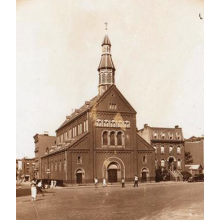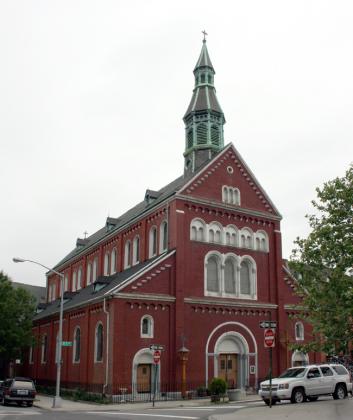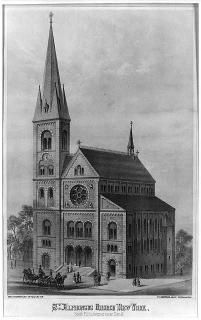The Church of the Annunciation of the Blessed Virgin Mary is the centerpiece of a fine complex of buildings located at North 5th Street and Havemeyer Street in Williamsburg. The parish buildings also includes a rectory, school and convent. The church occupies a prominent place at the confluence of North 5th Street, Havemeyer Street and Metropolitan Avenue. The provenance of the church has always been something of a mystery to me. According to the AIA Guide to NY, the church was designed by F. J. Berlenbach, Jr. and completed in 1870. But for a number of reasons, this attribution is not possible. Berlenbach can be documented as the architect of the convent and school on the west side of Havemeyer. But the design of the church – a Lombard basilica – does not appear to be from the same hand that gave us the High Victorian Gothic school and convent. Furthermore, in 1870, F. J. Berlenbach, Jr. was only 13 years old.
Franz J. Berlenbach, Jr. was born in Milwaukee, Wisconsin in 1857, the son of German-born carpenter of the same name. The father, Franz Berlenbach, Sr., moved to Brooklyn from Milwaukee in the early 1860s and soon became one of the Eastern District's most prolific builders. Berlenbach, Jr. may have worked for his father, but he was trained in architecture and worked for a short period in the office of James Renwick, Jr. By the late 1870s, Berlenbach, Jr. was working on his own, also in the Eastern District. Over the years, he built up a thriving practice as a designer of the ubiquitous frame tenements and as one of the Catholic church's go-to architects. One of his earlier works was the Queen-Anne style Berlenbach family house at 174 Meserole Street (1887: designated a City landmark in 2004).
With both father and son active in the building trades in north Brooklyn at the same time, it is not surprising that they are often confused (the Wikipedia page for F. J. Berlenbach, Jr. lists his father's year of birth, 1825).
The Parish of the Annunciation of the Blessed Virgin Mary was founded in 1864, an offshoot of Most Holy Trinity Church on Montrose Avenue (where the current church was designed by William Schickel in 1889 and built by F. J. Berlenbach, Sr.). The first church building for the predominantly German Annunciation congregation was constructed in 1863, probably a wooden structure located on the northwest corner of Havemeyer and North Fifth Streets, where the school is now located. Rev. J. Hauptman was the first priest of the parish.
Berlenbach, Jr. did design two buildings for the parish. The Real Estate Record lists Berlenbach, Jr. as the architect for the Convent of Order of St. Dominic (64 Havemeyer Street, 1889) and Annunciation School (70 Havemeyer Street, 1892) of the Annunciation BVM parish, so there is no doubt about the provenance of these two buildings. It is possible (though nowhere documented) that his father was the builder of the church itself. But it always struck me as improbable that Berlenbach, Jr. was the architect for the church itself.
The cornerstone for the current church was laid on August 22, 1869 by Bishop Loughlin, head of the Brooklyn Diocese. According the Brooklyn Eagle, “upwards of 5,000 people” attended the laying of the cornerstone. The construction of the building predates the establishment of the Brooklyn Department of Buildings, so there is no direct documentation of who the architect was. But after a lot of searching in contemporary periodicals, I was finally able to establish through an article in the New York Times that the architect of the church was indeed not Berlenbach, but rather Francis J. Himpler.
Himpler was born in Germany in 1833 and attended the Royal Academy of the Arts in Berlin. He designed churches in Europe before emigrating to the United States in 1867. Himpler was by no means prolific, but he was very talented. In the U. S., he designed a small number of churches and related buildings, all Roman Catholic and most for German parishes. His first U. S. commission was a Benedictine Abbey in Atchison, Kansas. Himpler’s other New York works were Melrose Roman Catholic Church in Westchester (now the Bronx, 1870), and the Church of St. Alphonsus Liguori on Laurens Street (later South Fifth Avenue, and now West Broadway) and Canal Street in New York (1871, demolished 1981). His most famous work is probably St. Joseph Church in Detroit (1873). He also designed the Academy of the Sacred Heart and the Church of Our Lady of Grace (1876), both in Hoboken, St. Francis de Sales Church in Cincinnati (1879).
Annunciation (Brooklyn, 1870) and St. Alphonsus (Manhattan, 1873) were both designed in the Lombard Romanesque style. With the exception of the tower at St. Alphonsus, the two churches are remarkably similar in their massing and detail. At Annunciation, Himpler used brick and Nova Scotia stone – a dense gray-colored sandstone (the building today is painted red with white stone trim, so it no longer has its original palette). Although Annunciation lacks the masonry of tower of St. Alphonsus, it does have a prominent copper lantern. The roof of the church and lantern would have originally been sheathed in slate (they are now covered in asphalt shingles).
In 1889, Annunciation parish undertook a major expansion of its campus, for which it hired F. J. Berlenbach, Jr. as its architect. The first building in this expansion was the convent, located on the west side of Havemeyer Street just north of North 5th Street. According to the Real Estate Record and Builders Guide, the convent was built to house the Sisters of Dominic, who prior to this time were located at Graham and Montrose Avenues. In 1892, Berlenbach designed the school at the corner of Havemeyer and North 5th. Both buildings are constructed of red pressed brick. The convent is trimmed in Belleville stone (a lighter-colored sandstone from New Jersey) and terra cotta. The Record and Guide does not list the builder for either building.
Some secondary records indicate that the church was reconstructed in 1889, with Berlenbach, Jr. listed as the architect. There is no record of a new building or alteration application in the Record and Guide and no reference to the work has been found in contemporary papers. While the exterior of the church retains all the appearance of an 1860s design, it is possible that the interior was remodeled around 1890, at what would have been the parish’s silver jubilee.
In 1914, the Annunciation Parish was taken over by a Lithuanian congregation and became a Lithuanian national parish, which is how it continues to operate today (although its services now include a daily mass in Spanish). The convent was converted to cooperative apartments in 1984. That project was funded by a revolving loan fund operated by the New York Landmarks Conservancy, and was completed largely with the sweat equity of the shareholders. The school building continues to operate, now as a school as a community services center. Northside Neighborhood School operates its preschool and grade school out of part of the building. The rectory (which probably dates to the mid-1870s) was converted from a one-family to a two-family residence in 2002.
According to the Landmarks Conservancy, the church was calendared for designation by the New York City Landmarks Preservation Commission in the 1980s, but that designation does not appear in DOB records. Regardless, the commission has never held a hearing for designation.
Berlenbach fils had a long and prosperous career in Brooklyn architecture. He designed many churches for the Diocese of Brooklyn, including St. Finbar, St. Joseph and Blessed Sacrament in Brooklyn and St. Aloysius and St. Matthias in Ridgewood. As late as the 1930s, the firm F. J. Berlenbach & Sons was designing buildings for the Diocese of Brooklyn. He died in Brooklyn in 1944.


